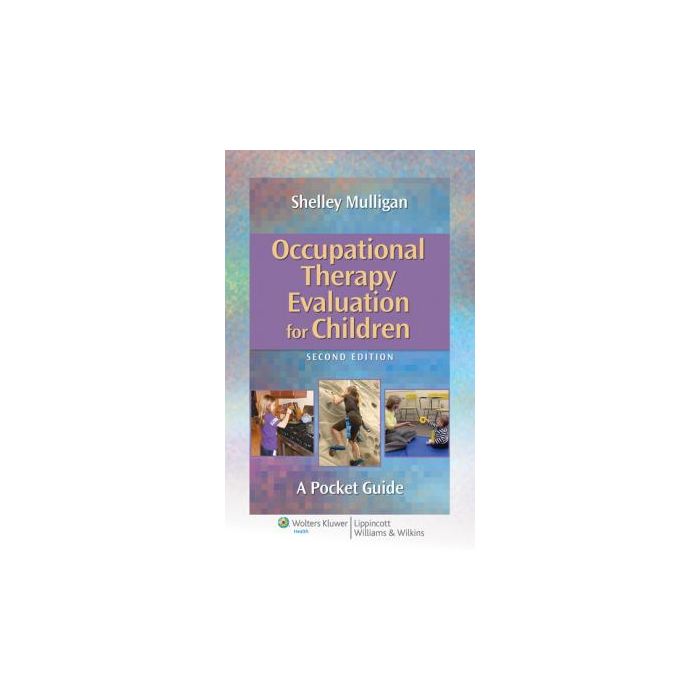Occupational Therapy Evaluation for Children, 2ed. [Mulligan - LIPPINCOTT Williams and Wilkins]

- ISBN/EAN
- 9781451176179
- Editore
- LIPPINCOTT Williams and Wilkins
- Formato
- Spirale
- Anno
- 2013
- Edizione
- 2
- Pagine
- 368
Disponibile
56,00 €
Master the skills and concepts necessary to effectively perform efficient evaluations of children with Occupational Therapy Evaluation for Children: A Pocket Guide, 2nd Edition. Reflecting the latest AOTA standards, this pocket-sized guide is a quick,comprehensive reference you can use throughout your education and into practice.
Providing an overview of theory as well as step-by-step coverage of techniques, the book includes clinical examples that illustrate the application of content, as well as client and family-centered practice; illustrations that demonstrate assessment techniques; and extensive tables that summarize key assessments, techniques, and actions.
See how concepts apply to practice with real world clinical examples.
Develop your skills and understanding with illustrations and photographs that demonstrate assessment techniques.
Expand your knowledge with a wide range of additional assessments, including COPM, MOHO, Sensory Profile, and visual and hand assessments.
· Develop practical skills for the workplace with new coverage of specialty areas, such as autism, where OTs have expanded their roles; up-to-date coverage of interview skills; information on IDEIA; and more.
Quickly access any assessment of interest using the table of assessments that appears at the beginning of the book.
Access a wide range of useful tools, including in-book tables that capture information in an easy-to-read manner and online sample evaluation forms.
Maggiori Informazioni
| Autore | Mulligan Shelley E. |
|---|---|
| Editore | LIPPINCOTT Williams and Wilkins |
| Anno | 2013 |
| Tipologia | Libro |
| Lingua | Inglese |
| Indice | Chapter 1: Introduction to OT Evaluation for Children Across Practice Settings This chapter will introduce the evaluation process, application of AOTA’s OT Practice Framework, the importance of using research evidence in the selection of evaluation tools and assessment strategies, discuss the OT clinical reasoning process for making clinical decisions regarding OT evaluations for children, and pediatric system and setting considerations. Client and family-centeredness, and the importance of implementing an occupation-based approach to assessment will be emphasized. Finally, content from CH 6, working as a member of a team will be moved to this first chapter. Sample assessment reports will all be moved to the Appendix. This chapter will change substantially. Chapter 2: A Guide to Evaluation: This chapter will include the steps in the evaluation process, and be updated to reflect the revised AOTA Practice Framework. This will not change substantially. Chapter 3: Typical Child Development: This chapter will provide an overview of developmental theories and principles, occupations of childhood, the development of motor, cognitive, perceptual, and social-emotional skills. This chapter will not change substantially. Chapter 4 Standardized Assessment Tools: This chapter will address the use and evaluation of standardized assessment tools. In addition, tables listing and describing various assessment tools will be included, with the tables updated to include some new tests, and with other tests based on reviewer feedback. The sample reviews could go in the Appendix, will 1 -2 new ones added. Chapter 5 Interviewing and Conducting Observations: This chapter will provide information about interview skills, and conducting observations. More information on making occupation-based observations, with tables summarizing the types of functional skills and play observations that should be considered with children of various ages will be included. Chapter 6 Intervention Planning and Documentation: this chapter will provide an introduction to the intervention planning process, including goal writing. Report writing and the presentation of assessment information with parents, and in the context of professional meetings will be covered. Sample assessment reports will be included in the Appendix. Chapter 7 Specialty Areas of Practice and Populations: This is the only new chapter. The areas of practice/populations that I propose to be covered include: evaluations of children with or suspected of having an autism spectrum disorder, evaluations of assistive technology needs, evaluations in neonatal intensive care units, evaluations for supporting adolescent in transition to adulthood, and evaluations for supporting outcomes-based research and occupation-based practice. |
Questo libro è anche in:
